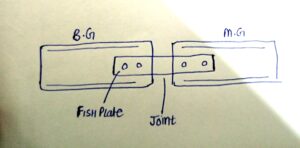Share
Get Access to:
Get Access to:
Lost your password? Please enter your email address. You will receive a link and will create a new password via email.
Please briefly explain why you feel this question should be reported.
Please briefly explain why you feel this answer should be reported.
Please briefly explain why you feel this user should be reported.
Rail joint: Rail joints are used to hold together the adjoining ends of the rails in correct position both vertical and horizontal planes. Rail joints forms the weakest part of the railway track. It is generally noticed that the strength of rail joints is 50 % of the strength of rails in the railwayRead more
Rail joint: Rail joints are used to hold together the adjoining ends of the rails in correct position both vertical and horizontal planes. Rail joints forms the weakest part of the railway track. It is generally noticed that the strength of rail joints is 50 % of the strength of rails in the railway track.
An ideal rail joint is that one which provides the same strength and stiffness as the other parts of the rail in the railway track.
Rail joints should provide enough space for free contraction and expansion.
A good rail joint should be easy for disconnecting so that in case of maintaining or changing the parts of railway track, that part can be easily taken out without disturbing the whole track.
Types of rail joints:
• Supported rail joint – When the rail ends rest on a single sleeper then the joint at that part is termed as supported rail joint.
• Suspended rail joint – When the rail ends are projected beyond the sleeper then the rail joint at that part is termed as Suspended rail joint. This type of rail joints are generally used with Timber or Steel sleepers on Indian railways.
• Bridge joint – When the suspended joints are connected with a flat plate called bridge plate then the joint is termed as bridge joint. Bridge joints are not used in Indian railways.
• Welded rail joint – Welded rail joints are considered as the best joints. These type of joints fulfill nearly all the requirements of an ideal joint. Welded joints are considered as the most perfect and strongest type of joints.
• Base joints – These joints are almost similar to bridge joints with a difference that, the inner fish plate are of bar type and outer fish plate are of special angle section whose horizontal leg is further extended over the sleeper to bolted with both bridge plate and sleeper .
• Compromise joints – When two different rail sections are required to be jointed together by means of fish plates which fit both the rails and joints is termed as compromise joint.

See less